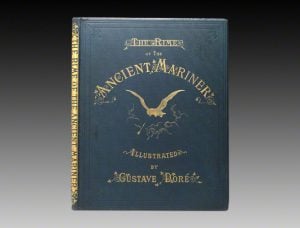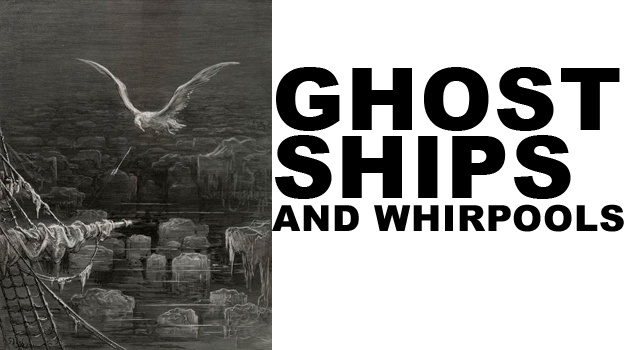In the mid- to late-19th century, there emerged a publishing practice of “gift books.” These editions were elaborately bound and often extensively illustrated. Usually published in the fall – with an eye towards the holiday season – gift books collected short fiction, poetry, and essays from popular authors. Edgar Allan Poe’s “The Pit and the Pendulum,” for instance, first appeared in such a volume.

Dovetailing with the gift book tradition was an increased demand for illustrated editions of classic literary works – The Inferno, Paradise Lost, Don Quixote, Morte d’ Arthur to name only a few of the more popular.
French illustrator and engraver Gustave Doré (“Dor-ray”) stands as one of the most successful book artists from this period. The most sought-after of his illustrated editions include Dante, Milton, Tennyson, Poe, Coleridge, and the Bible. And while there are varying opinions as to which is his best work, I’m going with his illustrations for Coleridge’s Rime of the Ancient Mariner every time.
First published in 1876, Doré’s Mariner went through 30 editions in the subsequent 25 years, which should give you a better idea of just how in-demand his work really was. (And, in fact, continues to be.) The book features an elaborately gilt pictorial cloth binding and 38 folio-sized engravings.*

As a rule, none of Doré’s engravings – for any of his works – are especially bright or cheerful. Instead, they are melancholy in the extreme. But, they are also masterful. Over the course of Mariner’s 38 engravings, Doré manages to render with equal skill ghost ships and whirlpools, angels and corpses, desperation and fleeting hope.
He is particularly gifted in his depictions of water: the chop and foam of the waves, the rising swell of a storm, the eerie flatness of a dead calm.
But perhaps the most arresting – if not what I would say is the most beautiful – image in Doré’s Mariner is the shooting of the albatross.
Dickinson wrote that “the difference between Despair / And Fear – is like the One / Between the instant of a Wreck / And when the Wreck has been.” That’s what Doré captures in this image – a disaster you see coming but cannot avert.
*In bookbinding, the term “folio” has a specific technical meaning, which is generally the way we use it at BRB. That said, in everyday practice, it is often used more generally when referring to a larger format book. Doré’s Mariner is roughly 16 x 19 inches.




Comments
15 Responses to “Gustave Doré: The Rime of the Ancient Mariner”
Cardmon says: June 20, 2013 at 1:10 pm
I heartily agree, these illustrations are just so powerful.
Embry Clark says: June 23, 2013 at 7:35 pm
Thanks, Cardmon! Dore is a favorite of mine, too. You should check out Dore’s work for Paradise Lost and the Bible, as well. They’re both equally compelling.
Charles Aston says: June 24, 2013 at 1:16 pm
Dore’s influence/importance to Barry Moser’s work is interesting and significant
Charles Aston says: June 24, 2013 at 1:19 pm
Dore’s influence and importance to our time is certainly important, as is his importance to the work of Barry Moser.
Embry Clark says: July 2, 2013 at 7:30 pm
I agree with you, Charles, about Dore’s influence, though I’m not as familiar with the work of Barry Moser. I’ll be sure to check him out – thanks for the recommendation.
Andrea Beaderstadt says: January 6, 2018 at 11:12 am
Hello:
Our Friends of the Library group sells some of our donated books on line to fund library programs. We recently received a copy of the Rime of the Ancient Mariner with the Dore illustrations. The book itself is in sad shape, worn corners with some foxing on the pages and even worse, some family member used the back and blank pages of the book to write our school assignments and even a crayon drawing of a pig! Despite this, the illustrations themselves are in reasonably good shape. We don’t know if a book in this condition is worth listing since we know some dealers remove art from old books and mat and frame them. Should we even attempt to sell this volume, and how do we price it? Any advice would be appreciated. Thank you.
Embry Clark says: May 12, 2020 at 2:56 pm
Hello Andrea: Unfortunately, we don’t offer appraisals. From your condition description, I’m sorry to say it sounds like it might not be a collectible copy.
Greg Rawlings says: April 19, 2018 at 2:10 pm
I have Coleridge/Dore Rime from 1881, published by the American News Company (NY). I am looking to see what demand there might be for the item. It’s quite beautiful.
Embry Clark says: May 12, 2020 at 2:51 pm
Hello Greg: Dore is quite popular with collectors, so we’re always interested to hear about first/early editions of his works. Please feel welcome to direct any books to sell inquiries to [email protected].
Adrian Dirschell says: October 2, 2018 at 2:16 pm
you know anyone interested in buying a copy of the Rime of the Ancient Mariner illustrated by Dore? I have the 1882 Harpers edition.
Embry Clark says: May 12, 2020 at 3:00 pm
Hello Adrian: Please feel welcome to direct any books to sell inquiries to [email protected].
Barbara Pedersen says: April 7, 2020 at 2:22 pm
I have a 1877 edition of The Rime of the Ancient Mariner illustrated by Gustav Dore. Each page is separated by a tissue insert. It was published by Harper Bros. The condition of the cover is not good, however the pages inside are intact. Is this worth anything? My husband has been carting this book around as we moved. He bought it as a teenager about 60 years ago.
Embry Clark says: May 12, 2020 at 2:20 pm
Hello Barbara, please feel welcome to direct any books to sell inquiries to [email protected].
Les Brown says: April 14, 2020 at 5:02 am
As a child attending a Services School in Cyprus in the mid sixties I was drawn to a copy of this book in our school library. Along with two friends I would dash upstairs at every opportunity, take it down from the shelf and pour over the gorgeous illustrations for hours. It is my favourite poem beautifully illustrated.
Embry Clark says: May 12, 2020 at 2:17 pm
Thank you for sharing such a wonderful memory, Les! Dore’s Mariner remains an absolute favorite of mine.